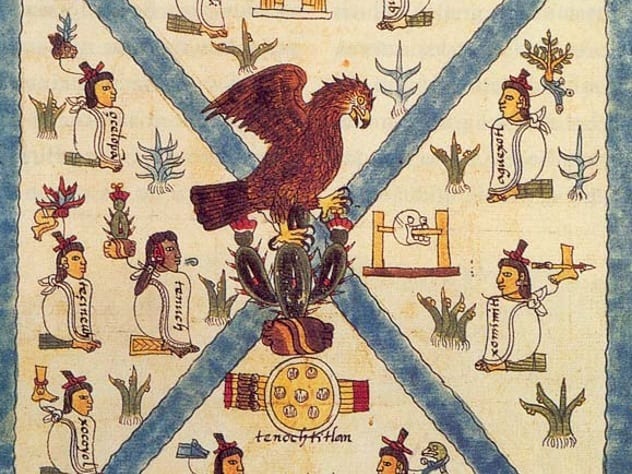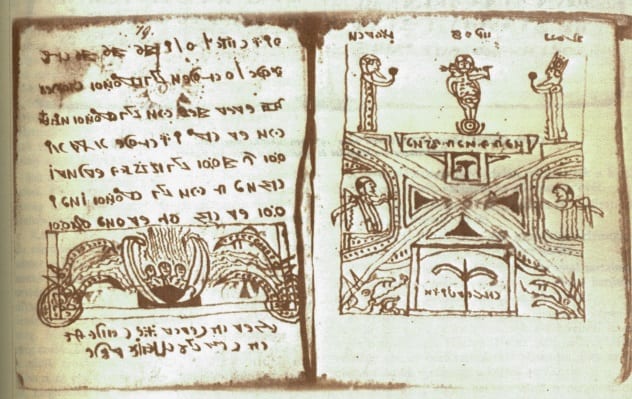 Technology
Technology  Technology
Technology  Humans
Humans 10 Everyday Human Behaviors That Are Actually Survival Instincts
 Animals
Animals 10 Animals That Humiliated and Harmed Historical Leaders
 History
History 10 Most Influential Protests in Modern History
 Creepy
Creepy 10 More Representations of Death from Myth, Legend, and Folktale
 Technology
Technology 10 Scientific Breakthroughs of 2025 That’ll Change Everything
 Our World
Our World 10 Ways Icelandic Culture Makes Other Countries Look Boring
 Misconceptions
Misconceptions 10 Common Misconceptions About the Victorian Era
 Mysteries
Mysteries 10 Strange Unexplained Mysteries of 2025
 Miscellaneous
Miscellaneous 10 of History’s Most Bell-Ringing Finishing Moves
 Technology
Technology Top 10 Everyday Tech Buzzwords That Hide a Darker Past
 Humans
Humans 10 Everyday Human Behaviors That Are Actually Survival Instincts
 Animals
Animals 10 Animals That Humiliated and Harmed Historical Leaders
Who's Behind Listverse?

Jamie Frater
Head Editor
Jamie founded Listverse due to an insatiable desire to share fascinating, obscure, and bizarre facts. He has been a guest speaker on numerous national radio and television stations and is a five time published author.
More About Us History
History 10 Most Influential Protests in Modern History
 Creepy
Creepy 10 More Representations of Death from Myth, Legend, and Folktale
 Technology
Technology 10 Scientific Breakthroughs of 2025 That’ll Change Everything
 Our World
Our World 10 Ways Icelandic Culture Makes Other Countries Look Boring
 Misconceptions
Misconceptions 10 Common Misconceptions About the Victorian Era
 Mysteries
Mysteries 10 Strange Unexplained Mysteries of 2025
 Miscellaneous
Miscellaneous 10 of History’s Most Bell-Ringing Finishing Moves
10 Absolutely Bizarre Books And Their Histories
Throughout recorded history, from the first assembling of glyphs and letters to modern-day philosophical treatises, humans have used writing to express their thoughts on life, themselves, the world around them, and what they truly believe. With this in mind, books can be simple, easy, and digestible for the average reader, readily available to anyone at the nearest bookshop, while others are more obscure in both content and history.
Some books are large, complex treatises that are almost indecipherable, hinting at the mysterious worlds that once lived inside of the minds of their authors. What were their real intentions? What were they trying to tell us or express? Some works of literature are far outside of the realm of what is considered accessible, yet all of our modern-day analyses point to them being legitimate works with intention. Some have mysterious origins, while others are contemporary with an unusual message. Since the dawn of literature, humanity has amassed many such works that aren’t your usual teen novel. Here are ten bizarre and strange books that you won’t believe actually exist.
10 The Codex Mendoza

The Codex Mendoza is an illustrated Aztec codex which was inscribed in approximately 1541 and contains an extremely in-depth history of the Aztec people, their kings, their lifestyles, the details of their culture, and more. It was written for the king of Spain by the newly subjugated Aztec people and was also inscribed with Spanish translations and explanations for much in the work so that it would be understood by the kingdom of Spain. It was annotated by a Spanish priest who was fluent in the language of Nahuatl, which was spoken by the Nahaus, the ethnic group which the Aztecs were a part of, and it was created, side from the annotations, entirely by indigenous people.[1] While this is not only unusual because of its age, insight into a very remote culture from the West, and historical significance, its tale gets even weirder from there.
The work was written for Emperor Charles V and was put on a ship destined for Spain, but it never arrived. The ships at sea were stopped and plundered by French pirates, and the book changed hands, winding up in France. There, it was purchased by a man named Andre Thevet, who inscribed his name into the work a total of five times and who was a cosmographer for France’s King Henry II. Two of those inscriptions contain the date 1553.
Later, an Englishman named Richard Hakluyt bought the Codex and took it to England, though, due to the obvious language difficulties, nobody seemed to really know what they had. It passed hands in England a few times before being turned in to the Bodleian Library at University of Oxford in 1659, five years after the death of its last known owner, a man named John Selden. There, it remained for 172 years, collecting dust on shelves, until it was discovered, brought to the attention of scholars, and found to be a legitimate document in 1831.
9 The Lucifer Principle

While The Lucifer Principle isn’t exactly a historical work that lay in obscurity, it earns its place on this list for the mere suggestions that it makes and for the public outcry it received, with some even suggesting that it attempts to use science to promote evil and even outright fascism. This work claims that evil, in a very Nietzschean way, isn’t just a bad, undesirable part of the human existence, one that we will hopefully someday banish from society, but is actually a creative force built within the very structures of our material existence.
Yes, it proposes that you are inherently evil in many aspects. So is society. So is nature. The subtitle is A Scientific Expedition into the Forces of History, and it achieves just that, touting an impressive list of sources of hard, concrete science to back up its claims, such as The Selfish Gene by Richard Dawkins, and attempts to piece together the story, from the tiniest genes to organisms to prehistoric warfare to societies to the massive, necessary superorganism that is human society, and shed light on our darker natures.
This work is a dose of cold, hard truth: Mother Nature is brutal, violent, and destructive. She creates through destruction in a never-ending cycle of creation and destruction, and this is built into the fundamental fabric of existence, the harsh reality being that evil and destruction are inescapable. With large sections such as “Bloodstains in Paradise” and “Why Humans Must Self-Destruct,” its content has challenged the delicate sensibilities of its readers since its original publication in 1995.[2] Some versions of the book’s cover clearly brag that many have called for it to be outright banned.
You’re not evil because you’re flawed; you’re evil because all of the structures of life are inherently partially evil . . . and the hard science of biology tells us this is how it is. Evil is in your DNA. Deal with it.
8 The Ripley Scroll

The Ripley Scroll is an English alchemical text that’s extremely occultist and obscurantist, hidden in its meaning and riddled with mysteries. The work is attributed to an Englishman named George Ripley, who lived from roughly 1415 to 1490. Its content is painfully elusive to grasp, and its age and obscurity only help to make it more difficult to understand. Most medieval works read like tales from another world, and this alchemical, occultist work is even more remote than the usual stuff of the day. Its delivery is almost something out of the Bible’s Book of Revelation, with confusing and cryptic lines. The book often references occultist symbolism in delivering concise yet indecipherable statements such as:
You must make Water of the Earth, and Earth of the Air, and Air of the Fire, and Fire of the Earth. The Black Sea. The Black Luna. The Black Sol.
. . . and
On the ground there is a hill
Also a serpent within a well
His tail is long with wings wide
All ready to flee by every side
Repair the well fast about
That thy serpent pass not out
For if that he be there a gone
Thou lose the virtue of the stone
Where is the ground you must know here
And the well that is so clear
And what is the dragon with the tail
Or else the work shall little avail
The goal, on the surface, seems to be to explain the inner workings of alchemy, the quest to transmute base metals into gold, or so most laypersons have thought. But alchemy is still largely hidden in obscurity. Take, for example, the quest for the Philosopher’s Stone, an unknown substance thought to be able to transform base metals into precious metals but also thought to be the “elixir of life,” which was believed to have all sorts of healing properties. Beyond this, the deeper, more Hermetic meaning of alchemy was the process of attempting to discover this substance, which was meant to purify the soul of the alchemist.
This is why the Ripley Scroll and many other alchemical works are so very dismally dense, almost surrealist works of literature, with intentions hidden in metaphor, abstraction, poeticism, and symobolism. Further adding to the confusion in understanding this work is the fact that it’s written in 15th-century Middle English poetics, much like the Chaucerian English of The Canterbury Tales, complete with rhyme, and thus emphasis was placed more strongly on imagery and poetics than clarity. This work is a delightful medieval mystery, and various formats, from the original to modern renditions, are available to be read online.[3]
7 The Satanic Scriptures

While also not covered in the obscurity of time or illegibility, The Satanic Scriptures, written by Peter Gilmore, the high priest of the Church of Satan, is a collection of essays, ideas, and social commentaries which have been largely overshadowed by The Satanic Bible, the work of Anton LaVey, the official founder of the church. In it, Gilmore discusses topics like how Satanists should marry as well as his opinions on gay marriage versus what he considers antiquated familial structures and provides a lot of insight into Satanic ceremonies. The work largely follows in content with the rest of the Satanic Principles, often espousing immorality as a doctrine for life as well as radical individualism. The Church of Satan has always been met with some shock by most people, and its less popular work which shows the inner workings of the thought process of the church is a guaranteed to be of interest to anyone with unorthodox tastes and a fascination with Satanism.
Gilmore likens people to black holes, some drawing others into their sphere of influence, powerful and moving on an individualist course, while others are parasitic in nature and attach to their hosts like a fetus in fetu, a fetus fused into the body of its twin before birth, reducing many individuals to nothing more than a pathetic collection of cells determined to spend their lives bottom-feeding off the powerful. Many of its chapters are available for free online via the Church of Satan for a glimpse into the dark and hedonistic world of the mind of High Priest Peter H. Gilmore.[4]
6 The Rohonc Codex

The Rohonc Codex is almost wholly indecipherable, in every literal sense of the word. Since it surfaced in the 19th century, it has been studied by scholars, linguists, and code-breakers, and yet, not a single word of it has been decoded or is even decipherable as actually a word that stems from any known language. This isn’t an ancient work from a culture whose history was shared by many and has been lost to time; this is a work written with the intention of obscurity and coded meaning—and no one can figure it out. This means that its authors went to great lengths to encrypt it with a code that even the greatest attempts from brilliant minds can’t figure out. It’s a deep, dark, mysterious puzzle.
This beautifully illustrated work’s history is masked in historical obscurity, the trail of its origins largely lost to time. Its first presumed historical appearance is from 1743, in the Rohonc Library in Hungary. While the work is definitely not Hungarian or a derivative thereof, it’s believed to have been a prayer book owned by someone Hungarian at some point. Its first appearance for certain comes in 1838, when a Hungarian living in England donated his entire library to the Hungarian Academy of Sciences.
It’s like what ancient Egyptian hieroglyphics were to us before the Rosetta Stone came along. Attempts at translating the Rohonc Codex into a modern language were made by the Hungarians starting in 1840, then again in 1884 and 1890, and all have failed completely.[5] This is truly one of the most mysterious works of literature in the world, and while some think the whole thing is an elaborate hoax, many believe it to be genuine. Maybe one day, we’ll crack the code and shed some light on its contents.
5 Prodigiorum Ac Ostentorum Chronicon
![]()
This work is also known by its anglicized name, The Chronicles of Portents and Prophecies, and it was written by a man named Conrad Lycosthenes in 1557. It contains a vast and lengthy collection of all the monsters, mysterious, occult beliefs, and even sightings of Halley’s Comet, monstrous beasts, and more, spanning from Adam and Eve, through ancient Greece, and onward to the medieval ages. It’s like an almanac for completely weird human beliefs from ancient history until 1557, and it contains many grim, fatalistic prophecies which closely resemble, in both writing and content, those of the contemporary author Nostradamus. It also contains sea monsters, natural disasters, and even what some believe is a UFO, some unknown space object which was likely a comet and was seen in Arabia in 1479.[6]
Its content and illustrations are the stuff of medieval nightmares and those long before, with two-headed monsters and plagues of locusts devouring the Earth. And, like the Ripley Scroll, its cryptic Middle English prose makes it a dark and delightful bit of wonder from a world far removed from ours today. It’s like a massive encyclopedia written in the same style as the Book of Revelation.
4 Codex Seraphinianus

Many readers throughout the ages, from the dawn of recorded literature until now, have tried to make their writings obscure and unusual for various reasons. Even in more modern times, writers have employed different tactics, such as using specialized terminology, abstraction, and what feels almost like a wholly different language, to convey their points. Sometimes, a reader can be relieved of their biases in order to see the world as if for the first time, through a different lens.
Such is it with one of the most bizarre books of all of history, Codex Seraphinianus, a work created by Italian artist, architect, and thinker Luigi Serafini during the late 1970s, though it contains medieval imagery and surreal illustrations.[7] The work wasn’t published until 1981, and even with its modern date, it’s still almost completely indecipherable, another work written in a coded language that no one can figure out. The work is somewhere in between surrealist art, with heads sliced into little, cleanly cut sections, drifting off and turning into other objects in little pieces on the ground, and science, with what looks like an anatomical description of the human body from the old 1800s anatomy texts.
The book clearly has a plot, but, like others on this list, the language in it is almost wholly unintelligible, not based on an alphabet used by any language known to humans—and this was probably the artist-author’s intention. In an increasingly information-oriented age, the subtle implications of encryption and coded messages are very present, making us question what we’re doing with all of this language we have and how we’re organizing it. Maybe one day, this work will be understood, but as of now, it’s more of an artwork with an illegible script than an easily readable book, that’s for sure.
3 The Nag Hammadi Codices

The Nag Hammadi Codices are a vast collection of Christian manuscripts that remained buried in the Egyptian desert for an astonishing 1,600 years and were only unearthed in 1945. They collectively form the basis for Christian Gnosticism, which is now only starting to be pieced together today, after lying dormant for over 1,600 years, much like the mummies of ancient Egypt. Attempts were made to destroy a number of narrative-deviating works as ancient early Christian politics began to form a uniform message. Many works that we now know of today were excluded from the Holy Bible for political and religious reasons, and the Nag Hammadi Codices are the mother lode of these. They contain the only complete text of the Gospel of Thomas, one of the most interesting books, largely a collection of the supposed sayings of Jesus.
This is a massive library offering alternative accounts of the life of Jesus, comprised of 52 texts in 13 leather-bound volumes.[8] Early Christianity had a lot more sects and texts than we can even begin to know about, like an ocean of mystery, and this great find has shed a lot of light on the inner workings of the beliefs of early Christians. They give us alternate accounts and thought processes, new stories to think upon, and new allegories to consider and completely change the world of Christianity outside of the common narrative of the traditional Church. The Gnostic approach sheds an almost occult-like light on Christianity.
2 The Voynich Manuscript

The Voynich manuscript has been called “the book that no one can read” by Dictionary.com, and for a very good reason: Like a few others on this list, absolutely no one can read it. “Idioglossia” is a term for a private language intended for only a few people to decipher, and such languages have been around since ancient times, up through occult history, and even are employed every day today in the modern prison system, where inmates have to speak in code to one another in hopes that their messages cannot be broken. This manuscript contains its own writing system that is totally unrelated to any known today.[9]
The Voynich manuscript is believed to have been written in the 15th or 16th centuries, making it another old work with weird, obscure origins which has found its way into our hands in modern times. Its author is unknown. A bookseller named Wilfrid Voynich purchased the book in 1912, hence the name, but the rest of its origins are extremely difficult to trace. The work is rife with illustrations detailing many, many different things. Some of its pages hint at astrology, with Zodiac symbols, moons, suns, and other celestial bodies, while others seem to be a very rudimentary sort of botany or chemistry, with plants and fruits in various elaborate jars, perhaps suggesting a book of early medicine.
Theories galore have come up about the possible origins of the mysterious book, and all of them have been shot down, failing miserably. It has been carbon-dated, which tells us that the material it is written on is likely from the 1400s, but since then, scholars, cryptologists, and linguists alike have all failed to explain the origins and meaning of the book. It is believed that the manuscript was likely once owned by the Holy Roman emperor Rudolf II, and what is known for certain is that one of the pages have been inscribed with the emperor’s court pharmacist and chemist’s name, a man named Jacobus Horcicky de Tepenec. This signature could only be detected by ultraviolet light and is invisible to the naked human eye. The Voynich manuscript is a truly modern mystery, a book possibly full of a seemingly impenetrable meaning which has been eroded by the sands of time.
1 Might Is Right

Might Is Right or The Survival of the Fittest is a bizarre work written under the pseudonym Ragnar Redbeard, though nobody knows its author’s true name. The definition of the phrase “might is right” is listed in the Oxford English Dictionary as being that the powerful can do whatever they want unchallenged, even if what they want is totally unjust.
This weird, bizarre, deeply unethical, and disturbing book was first published in 1890. During the modest Victorian culture of England, it’s no surprise that this work, which challenges all of our long-held cultural values (pretty much all of them, actually), had to be published anonymously, as the author might have been jailed or killed simply for its dark and disturbing content. Might Is Right is on many lists of banned books, and while it can be found online, even most publishers today refuse to carry it because of its cold, uncaring, psychopathic nature, which espouses egoism, anarchy, and strength, even if they need to come at the expense of any sort of social ethics.
A work of complete social Darwinism, Might Is Right rejects any and all ethics, including natural, human, and civil rights or any rights at all that aren’t founded in power and might. According to the book, might is the only thing that can establish a right in this world. Your rights don’t exist unless you have the physical power to back them up in a fight. The obvious shock and awe of this message has been frowned upon almost as much as Machiavelli’s famous work The Prince, and it reads much like The Prince—only much more twisted and depraved. Whether you’re a book collector or someone who just fancies historical nostalgia and bizarre ideas, Might Is Right is definitely within the top few most extreme books to ever exist.[10] Content-wise, there are simply few, if any challengers.
I like to write about the the bizarre, the strange, the unusual, philosophy, and history.
Read about more mysterious books on 10 Ancient Books That Promise Supernatural Powers and 10 Ancient Lost Books We Would Love To Read.








